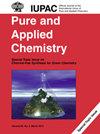A review on the green chemistry perspective of multipurpose use of cow urine
IF 2
4区 化学
Q3 CHEMISTRY, MULTIDISCIPLINARY
引用次数: 0
Abstract
The use of cow urine (CU) in treating a variety of illness can be traced back to ancient ages. It has been referred as an important and integral component of Cowpathy – an age-old practice in Indian sub-continent since the Vedic period (1500 BC – 600 BC). The CU contains several important compounds that are essential in maintaining a balance between the well-being of human and the nature. It is composed of about 95 % water and other useful ingredients such as urea, hormones, lyase enzyme, and salts containing Fe, Ca, P, Mn, S, N, and K. In addition, it also contains lactose, cytokine, and amino acid which are the fundamental building blocks of protein. Researchers have developed various processes for the green synthesis of CU concentrate and evaluated its usefulness in treating various diseases owing to its antibacterial and antifungal properties. Further, CU has also shown promising immunity boosting and anti-oxidant characteristics. Even though human civilization has benefited from the use of CU in treating various types illness but the modern scientific understanding of the cause-effect relationships was partly developed in the last few decades. There exists a huge knowledge gap and a comprehensive study on exploring the science and application of CU hasn’t been reported. This paper reviews the historical perspective, compositional analysis, processing, applications, knowledge gap, and future research required in the field of therapeutic usage of CU.从绿色化学角度审视牛尿的多用途使用
使用牛尿(CU)治疗各种疾病的历史可以追溯到古代。自吠陀时期(公元前 1500 年至公元前 600 年)起,牛尿就被称为印度次大陆古老疗法--牛病疗法的重要组成部分。CU 含有几种重要的化合物,对维持人与自然之间的平衡至关重要。它由大约 95% 的水和其他有用成分组成,如尿素、激素、裂解酶以及含铁、钙、磷、锰、硫、氮和钾的盐类。研究人员已开发出多种绿色合成 CU 浓缩物的工艺,并评估了其抗菌和抗真菌特性在治疗各种疾病方面的用途。此外,CU 还具有增强免疫力和抗氧化的特性。尽管人类文明已从使用 CU 治疗各种疾病中获益,但现代科学对因果关系的认识部分是在过去几十年中形成的。对 CU 的科学探索和应用的全面研究尚未见报道,存在着巨大的知识空白。本文回顾了 CU 的历史观点、成分分析、加工、应用、知识差距以及在治疗应用领域所需的未来研究。
本文章由计算机程序翻译,如有差异,请以英文原文为准。
求助全文
约1分钟内获得全文
求助全文
来源期刊

Pure and Applied Chemistry
化学-化学综合
CiteScore
4.00
自引率
0.00%
发文量
60
审稿时长
3-8 weeks
期刊介绍:
Pure and Applied Chemistry is the official monthly Journal of IUPAC, with responsibility for publishing works arising from those international scientific events and projects that are sponsored and undertaken by the Union. The policy is to publish highly topical and credible works at the forefront of all aspects of pure and applied chemistry, and the attendant goal is to promote widespread acceptance of the Journal as an authoritative and indispensable holding in academic and institutional libraries.
 求助内容:
求助内容: 应助结果提醒方式:
应助结果提醒方式:


